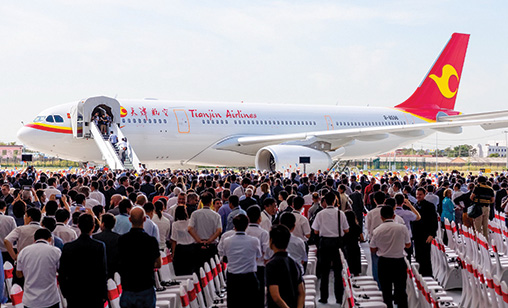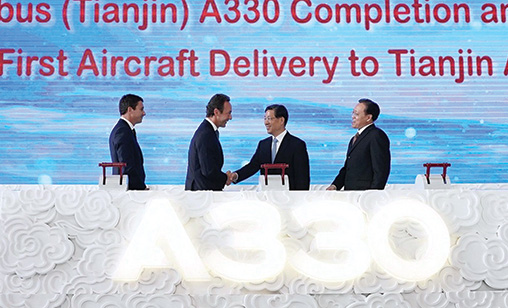News
Airbus strengthens China ties with A330 Tianjin centre
Joint venture partners, Airbus and China’s AVIC, added more industrial might to their relationship with the opening of US$200 million A330 Completion & Delivery Centre in China last month. Chief correspondent, Tom Ballantyne, reports from Tianjin.
October 1st 2017
When it comes to co-operation with China, Airbus chief operating officer and president commercial aircraft, Fabrice Brégier, has absolute clarity about Airbus’ strategic goals. Read More »
Speaking at the opening ceremony of the joint venture A330 Completion & Delivery Centre in Tianjin last month, he said: “This is the best demonstration of a strategy that is balanced with Chinese partners who are strong and [you have] a good product, yes, it helps you penetrate the market,” he said.
 |
Brégier said following the ground breaking rollout of the its joint venture A320 Final Assembly Line in Tianjin 12 years ago, the group’s new investment in Tianjin was fundamental to its long-term goal of dominating aircraft sales in China.
Brégier also confirmed that a ramp up in the number of A320s was being considered and that a completion delivery centre for Airbus’ latest wide-body, the A350, was a possibility given there were enough orders for the aircraft from Chinese airlines.
Describing China as a “very business friendly country”, Brégier said: “there is a direct connection between your investment and your capabilities to demonstrate you care about the Chinese industry and, at the same time, your market access.”
Airbus’ market share in China had increased from 20% to almost 50% since the Toulouse headquartered manufacturer opened its A320 Final Assembly Line in Tianjin, he said.
Brégier handed over the first A330 completed at Tianjin to Tianjin Airlines at the opening of the C&DC. While the A320 is assembled in Tianjin with components shipped from Europe, A330 aircraft passing through the C&DC are built in Europe then flown to the Mainland empty and unpainted.
When the airplanes arrive in Tianjin, the completion process includes cabin installation, aircraft painting, production flight tests, customer flight acceptance and aircraft delivery. More than 150 Chinese employees at the new C&DC were trained in Toulouse to staff the new facility.
Whether C&DCs for other aircraft types will be constructed remained to be seen. Brégier said in Tianjin that Chinese carriers had ordered around 50 A350s. “We are supposed to deliver the first A350s to our Chinese customers before the end of this year. The A350 will be fantastic for the trans-Pacific network with its range and the seat count. Then the C&DC will be involved later to move to the A330 neo and the A350. We see it in the plan. We have additional big investment.”
More problematic is the A380, which has been short of orders for several years. President and chief executive of Airbus China, Eric Chen, made a gutsy forecast about A380 prospects at the Tianjin launch when he said Chinese airlines (there are five A380s in China operated by China Southern) could be set to buy the plane in big numbers.
“What I can say is that if one airline takes the lead to order, the others will most probably follow. I would expect a domino effect. I am working to produce that domino effect which has not happened yet,” Chen said.
 |
| 'It is fair to accept that the biggest market for us [China] also deserves some industrial investment if we are to be seen as a good Chinese citizen. And I do believe we are seen, to a large extent, as a good Chinese citizen' |
| Airbus COO and commercial aircraft president, Fabrice Brégier, speaking at the opening of the joint venture A330 completion & delivery centre in Tianjin on September 20 |
“But I would expect them [Chinese airlines] to have 60 to 100 A380s. When I look at the market flow, the passenger flow and the route by route economics, I am fully confident Chinese carriers will need a minimum of 60 A380s in the next five to seven years.”
Brégier said a C&DC for the A380 was a different question to be addressed. “We invest in this facility when there is a big market. So we need to make sure the market is mature. If there is a market, we are ready. We know how to co-operate and it might well also be on the A380,” he said.
In the meantime, Airbus was studying an increase in production of its A320 aircraft. “We plan to ramp up to 60 aircraft a month - total production worldwide - there is extra potential. We have invested in a fourth assembly line in Hamburg. It would make sense to increase the output from China, which is our biggest market, so if we find a way to do it in a competitive manner we will decide to ramp up. The goal is to do it without substantial additional investments,” Brégier said.
The new C&DC has a paint shop, a weighing hangar and one main hangar with three aircraft positions spread across 16,800 square metres. It will employ more than 250 people and will be ready to deliver two aircraft a month by early 2019.
“The inauguration of our A330 C&DC in Tianjin, together with the first of many deliveries, marks a new milestone for Airbus’ international footprint and underlines the strong spirit of cooperation with our Chinese partners,” said Brégier. “Wide-body aircraft completed in China is an Airbus, and an industry, first which demonstrates our mutual commitment to a strong and growing Chinese aviation sector.”
“We are extremely pleased with the partnership we have at Tianjin. We don’t intend to duplicate the assembly line for the A320. We have extended this partnership until 2026 [with AVIC] and I can tell you it will go much further because the A320 will be successful until at least 2030 for sure.
“The question mark will be what do we do when the new generation aircraft from Airbus are to be launched? We still have a few years to think about that.”
While single aisle planes are a big part of the Airbus order book, Brégier sees more growth in China’s wide body fleet. “There are two elements that justify a growth of wide bodies. First of all, I am sure part of the domestic market will move to wide bodies,” he said.
“We have probably 60 330s flying domestic missions every day by Chinese customers, which is already significant, and that will continue because there are slot shortages. The second reason is you can see a big progression in traffic from and to China.
“The growth is probably around 20% to 30% every year so there will be more demand for wide bodies. This is why we invested in this cabin completion centre in China. It was supported initially by the first global order of 75 A330ceos [from China]. We expect soon to have additional orders.”
Three of the world’s top five A330 operators are Chinese: Air China, China eastern and China Southern – and there are 202 A330 family aircraft flying with Mainland carriers.